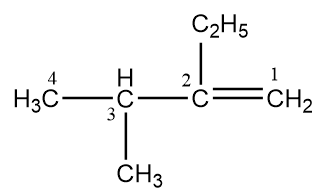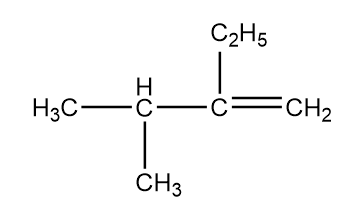
Answer
365.7k+ views
Hint: In IUPAC nomenclature, the rational system must have at least two things i.e., first it should indicate that how the carbon atoms of a given compound are bonded together in a characteristic lattice of rings and chains and secondly, it should identify and locate any functional group (if present), in the compound.
Complete Step By Step Answer:
As per the question, the given compound is an alkene and IUPAC rules for naming alkene and cycloalkene are as follows:
1. The name should contain an ene suffix i.e., the IUPAC name ending with “ene” represents alkene or cycloalkene.
2. The longest chain chosen for the base or root must contain both carbon atoms of the double bond.
3. The chain must be numbered in such a way that the double bond gets minimum allocation i.e., it must be numbered from the end nearest the doubly bonded carbon atom.
4. If in case, more than one double bond is present in the compound then the compound is named as diene, triene and so on.
5. The names of functional groups are always written in alphabetical order.
According to these rules, the numbering for the given compound will be as follows:

In the compound, an ethyl group is present at the second position and at third position, a methyl group is present. Hence, the IUPAC name of the given compound is 2-Ethyl-3-methylbut-1-ene.
Thus, option (B) is the correct answer.
Note:
Remember that we can recognize organic compounds from their common names as well. The IUPAC names strictly follow an internationally accepted set of rules set by the international union of pure and applied chemistry whereas the common names do not have any rules and are easy to remember as they do not contain any digits, suffixes and prefixes.
Complete Step By Step Answer:
As per the question, the given compound is an alkene and IUPAC rules for naming alkene and cycloalkene are as follows:
1. The name should contain an ene suffix i.e., the IUPAC name ending with “ene” represents alkene or cycloalkene.
2. The longest chain chosen for the base or root must contain both carbon atoms of the double bond.
3. The chain must be numbered in such a way that the double bond gets minimum allocation i.e., it must be numbered from the end nearest the doubly bonded carbon atom.
4. If in case, more than one double bond is present in the compound then the compound is named as diene, triene and so on.
5. The names of functional groups are always written in alphabetical order.
According to these rules, the numbering for the given compound will be as follows:

In the compound, an ethyl group is present at the second position and at third position, a methyl group is present. Hence, the IUPAC name of the given compound is 2-Ethyl-3-methylbut-1-ene.
Thus, option (B) is the correct answer.
Note:
Remember that we can recognize organic compounds from their common names as well. The IUPAC names strictly follow an internationally accepted set of rules set by the international union of pure and applied chemistry whereas the common names do not have any rules and are easy to remember as they do not contain any digits, suffixes and prefixes.
Recently Updated Pages
Who among the following was the religious guru of class 7 social science CBSE

what is the correct chronological order of the following class 10 social science CBSE

Which of the following was not the actual cause for class 10 social science CBSE

Which of the following statements is not correct A class 10 social science CBSE

Which of the following leaders was not present in the class 10 social science CBSE

Garampani Sanctuary is located at A Diphu Assam B Gangtok class 10 social science CBSE

Trending doubts
A rainbow has circular shape because A The earth is class 11 physics CBSE

Fill the blanks with the suitable prepositions 1 The class 9 english CBSE

Which are the Top 10 Largest Countries of the World?

How do you graph the function fx 4x class 9 maths CBSE

The Equation xxx + 2 is Satisfied when x is Equal to Class 10 Maths

Give 10 examples for herbs , shrubs , climbers , creepers

Change the following sentences into negative and interrogative class 10 english CBSE

Difference between Prokaryotic cell and Eukaryotic class 11 biology CBSE

Why is there a time difference of about 5 hours between class 10 social science CBSE





